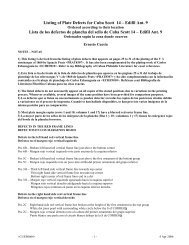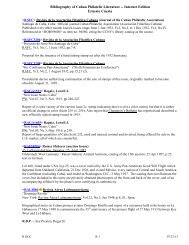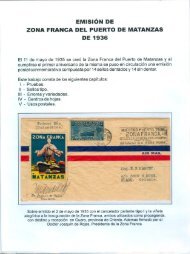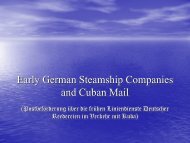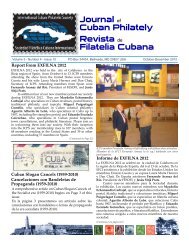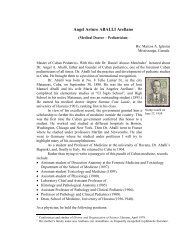The Cuban Philatelist - Ernesto Cuesta
The Cuban Philatelist - Ernesto Cuesta
The Cuban Philatelist - Ernesto Cuesta
You also want an ePaper? Increase the reach of your titles
YUMPU automatically turns print PDFs into web optimized ePapers that Google loves.
En marzo de 1985 se llevó a cabo en La Habana la<br />
Exposición Filatélica Internacional ESPAMER ’85. El tema de<br />
las exposiciones ESPAMER es la confraternidad filatélica entre<br />
España y sus antiguos territorios en Latino América. En<br />
conmemoración de ESPAMER ‘85 se emitieron una serie de<br />
seis sellos y una hojita souvenir (Scott 2773-2779) con<br />
ilustraciones de la vida de los taínos tomadas de las crónicas<br />
españolas actualizadas con información obtenida de trabajo<br />
antropológico de naciones suramericanas distantemente<br />
relacionadas.<br />
El sello de un centavo muestra hombres taínos jugando<br />
a la pelota, que semeja la descripción dada por el Padre<br />
Escobedo en La Florida. El sello de dos centavos muestra a un<br />
sacerdote taíno conduciendo una ceremonia cohoba en un lugar<br />
sagrado con ídolos cemíes. El sacerdote está inhalando polvo<br />
cohoba para inducir un trance halucinógeno que le permite el<br />
contacto con los dioses taínos. El dibujo se basa en una<br />
descripción del ritual taíno cohoba dada por el cronista español<br />
Padre Ramón Pané en Un Recuento de las Antigüedades de los<br />
Indios. El sello de cinco centavos muestra taínos en canoas de<br />
madera pescando en aguas costeras. Los taínos usaban canoas<br />
de distintos tamaños hechas de troncos para cazar la fauna<br />
marina y viajar entre las islas del Caribe. La misma palabra<br />
canoa es taína, y éstas maravillaron al Almirante Colón, que<br />
describió que las más grandes podían fácilmente transportar<br />
treinta o más pasajeros.<br />
El sello de veinte centavos muestra a una mujer taína<br />
haciendo cerámica. Los taínos, al igual que todas las naciones<br />
amerindias, fabricaron cerámicas de barro que eran horneadas.<br />
Las cerámicas taínas más comunes eran platos de arcilla<br />
llamados burén, utilizados para cocinar pan de yuca, y una serie<br />
de platos hondos decorados. La producción de cerámicas se<br />
considera una característica distintiva de la cultura taína en<br />
contraste con la Siboney que carecía de élla. El sello de treinta<br />
centavos muestra un hombre taíno cazando con un niño. El<br />
niño sostiene una jutía, un roedor nativo que era cazado por su<br />
carne. Los taínos eran hábiles cazadores de la fauna terrestre y<br />
marina usando flechas y redes. El plato cubano tradicional,<br />
ajiaco, se deriva de la cocina taína.<br />
El sello de cincuenta centavos muestra dos hombres<br />
taínos en una playa. Uno está haciendo una canoa, quemando y<br />
ahuecando un tronco. El segundo taíno está decorando un largo<br />
remo usado para mover la canoa. Los taínos poblaron todas las<br />
islas habitables del Caribe, probablemente usandos puntos<br />
astronómicos para la navegación. También hay evidencia que<br />
otras gentes visitaron el mundo taíno. Los habitantes de la<br />
península del Darién en Panamá eran miembros de la nación<br />
araucana y utilizaban el oro para producir ornamentos. Se cree<br />
que un ornamento de oro encontrado en un entierro taíno en<br />
1986 en el Chorro de Maita en la región de Yaguajay provino<br />
del Darién.<br />
La hojita souvenir de un peso muestra dos mujeres<br />
taínas rayando y cocinando yuca. La planta de yuca (Manihot<br />
utilissima) también conocida como manioca, era llamada<br />
yucaiba por los taínos, tuvo su origen en Sur América donde<br />
In March 1985, the ESPAMER ’85 International<br />
Stamp Exposition was held in Havana. <strong>The</strong> theme of the<br />
ESPAMER exhibitions is philatelic fraternity between Spain<br />
and its former territories in Latin America. In commemoration<br />
of ESPAMER ‘85, a set of six stamps and a souvenir sheet<br />
(Scott 2773-2779) were issued with illustrations of Taino life<br />
drawn from the Spanish chronicles updated with more current<br />
information drawn from anthropological work done among<br />
distantly related South American Amerindian nations.<br />
<strong>The</strong> one-centavo stamp shows Taino males playing the<br />
ball game, more closely matching the description given by<br />
Father Escobedo in La Florida. <strong>The</strong> two centavos stamp shows<br />
a Taino priest conducting the cohoba ceremony in a sacred<br />
space with cemi idols. <strong>The</strong> priest is inhaling cohoba powder to<br />
induce a hallucinogenic trance to enable him to connect with<br />
the Taino deities. <strong>The</strong> drawing is based on a description of the<br />
Taino cohoba ritual given by Spanish chronicler Father Ramon<br />
Pane in An Account of the Antiquities of the Indians. <strong>The</strong> five<br />
centavos stamp shows Taino in wooden canoes fishing along<br />
coastal waters. <strong>The</strong> Taino used canoes of various sizes, hewn<br />
from wood logs to hunt marine fauna and to voyage among the<br />
islands of the Caribbean. <strong>The</strong> word canoe itself is a Taino word;<br />
the canoes of the Taino were the marvel of Admiral Columbus,<br />
describing larger models that could easily transport thirty or<br />
more passengers.<br />
<strong>The</strong> twenty centavos stamp shows a Taino woman<br />
making ceramics. <strong>The</strong> Taino like all Amerindian nations<br />
fashioned ceramics using coils of clays, which were then baked.<br />
<strong>The</strong> most common Taino ceramics were clay dishes called<br />
buren, used to bake yucca patties, and an assortment of<br />
decorated bowls. <strong>The</strong> production of ceramics is considered a<br />
distinguishing feature of the Taino culture in contrast to the<br />
aceramic Siboney. <strong>The</strong> thirty centavos stamp shows a Taino<br />
male with a child hunting. <strong>The</strong> child holds a jutia, a native<br />
rodent that was hunted for its delicate meat. <strong>The</strong> Taino were<br />
skilled hunters of fauna on both land and sea using arrows and<br />
nets. <strong>The</strong> traditional <strong>Cuban</strong> stew, ajiaco, traces its roots to<br />
Taíno cuisine.<br />
<strong>The</strong> fifty centavos stamp shows two Taíno males on a<br />
beach. One is making a canoe by burning and hollowing a<br />
wooden log. <strong>The</strong> second Taíno is decorating a long armed<br />
paddle, which provided the power source for the canoe. <strong>The</strong><br />
Taíno had populated every inhabitable island of the Caribbean,<br />
likely using astronomical points to fix navigational locations in<br />
order to find their way. <strong>The</strong>re is also evidence that other<br />
peoples visited the Taíno world. <strong>The</strong> inhabitants of the Darien<br />
peninsula in Panama were a related Arawak nation that used<br />
native gold to produce ornaments. A gold ornament recovered<br />
in 1986 from a Taíno burial at Chorro de Maita in the Yaguajay<br />
region is thought to have originated in the Darien.<br />
<strong>The</strong> one peso souvenir sheet shows two Taino women<br />
grating and baking yucca. <strong>The</strong> yucca plant (Manihot utilissima)<br />
also known as manioc, was known to the Taino as yucaiba,<br />
originating in South America where it was domesticated to<br />
produce roots eaten for their high carbohydrate content. Before<br />
the Spanish conquest, yucca provided the main carbohydrate<br />
81 <strong>The</strong> <strong>Cuban</strong> <strong>Philatelist</strong>. Last Half 2005.



